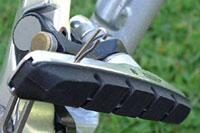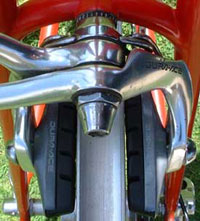Brake Maintenance

Brake pads (sometimes called “brake shoes”) are what rub against your rims to provide stopping power when you squeeze the brakes. This rubbing action means that the pads require occasional maintenance to function optimally. And also, that the pads will wear out after a while and need to be replaced. Here are our guidelines for keeping your brake pads in tip-top shape.
Please note that these instructions are for conventional brakes, not disc brakes. If you need to adjust your disc brakes, please bring them in for servicing. Also, because brakes are so important for safety, we do not recommend working on them unless you’re confident in your ability to do the job right. And, keep in mind that in order for brakes to work properly and to make the adjustments explained in this article, the wheels must be true and round (no side-to-side wobbles, up-and-down hops or bends).
If you have any questions about brake adjustment please give us a call or bring your bike in and we’ll be happy to help.
Keep the pads clean and free of debris
For optimum braking, the rims and brake pads must be clean. As you use your brakes, however, the pads strike the rims picking up anything on them and sometimes transferring rubber deposits to the rims. The pads even pick up bits of sand and gravel that then grind the sides of the rims as you brake wearing them prematurely. This is another reason it's important to keep the pads and rims clean (rim replacement is expensive).
 To clean them, dampen a corner of a rag with rubbing alcohol and scrub the rims to remove any rubber deposits or grimy build up. Then wipe the surfaces of the brake pads to clean them.
To clean them, dampen a corner of a rag with rubbing alcohol and scrub the rims to remove any rubber deposits or grimy build up. Then wipe the surfaces of the brake pads to clean them.
Also, look closely at the faces of the pads (this is easiest if you remove the wheel). Sometimes you’ll find embedded shards of aluminum from the rims. Or, you might find small pieces of sand or stone left over from your last muddy mountain-bike ride. Pick any debris out with a pointed instrument (photo), such as an awl. This will improve braking and save your rims.
Replacing brake pads
How often you need to replace brake pads depends on where and how you ride. The important thing is that you understand how to check your pads so that you don’t end up without brakes when you need them.
Brake pads wear down a little every time you apply the brakes and you feel the change at the levers. As the pads wear, you have to pull the levers further before the brakes start to grab.
 When the pads are really worn, you’ll squeeze the levers hard and the pads won’t grip the way they once did. This is a sign that it’s time for new pads to restore your braking. Don’t put off this important maintenance because when the pads wear down all the way, you’ll have no braking power, which is dangerous. In some cases, when the pad is worn out, the metal pad holder contacts the rim and it will only skid along the slick surface of the rim providing little grip and no braking power.
When the pads are really worn, you’ll squeeze the levers hard and the pads won’t grip the way they once did. This is a sign that it’s time for new pads to restore your braking. Don’t put off this important maintenance because when the pads wear down all the way, you’ll have no braking power, which is dangerous. In some cases, when the pad is worn out, the metal pad holder contacts the rim and it will only skid along the slick surface of the rim providing little grip and no braking power.
It’s a good idea to check your pads visually before rides, too. New brake pads have grooves in them (photo). These channel water away from the rims to improve wet-weather braking. They’re also a convenient way to gauge pad wear. When the grooves are almost worn away, it’s time for new pads.
Pad types
 There are two types of brake pads, cartridge and bolt-on. The former is much easier to replace because it simply slips into the holder and you’re good to go. Bolt-on pads must be aligned during installation, which requires practice to get right.
There are two types of brake pads, cartridge and bolt-on. The former is much easier to replace because it simply slips into the holder and you’re good to go. Bolt-on pads must be aligned during installation, which requires practice to get right.
If you have cartridge pads, there’ll be an open end on the back of the pad holders (the metal piece the pad slips into; see photo). Sometimes, there’s a pin (linear-pull brakes) or an Allen bolt (sidepull brakes) that keeps the pad in place. To replace the pads, remove the pin (photo) or bolt, push out the bad pad, install the new one and reinstall the pin or bolt (if necessary).
 Keep in mind that pads usually fit a certain way (photo). Look for markings or compare the new one to the old one to make sure it’s oriented correctly (it's always best to replace one pad a time so you can compare the new one with the one still in place).
Keep in mind that pads usually fit a certain way (photo). Look for markings or compare the new one to the old one to make sure it’s oriented correctly (it's always best to replace one pad a time so you can compare the new one with the one still in place).
Pads might be tight, too. If you can’t push it out, try slipping a small screwdriver between the pad and its holder and prying to get it out. You should be able to push the new pad in with your fingers. If it’s a tight fit, make sure you’re putting it in the right way. You can also breathe on the pad to wet it slightly, which will make it slide in easier. Or, wet it with some of the rubbing alcohol. This won't harm the pad and it will evaporate quickly.
 Bolt-on pads are usually one piece with a bolt or post (photo). To replace these pads, loosen the bolt holding it in place (remove it if necessary), take out the old pad and insert a new one. Then, carefully align the pad so that it strikes the rim squarely when the brake is applied.
Bolt-on pads are usually one piece with a bolt or post (photo). To replace these pads, loosen the bolt holding it in place (remove it if necessary), take out the old pad and insert a new one. Then, carefully align the pad so that it strikes the rim squarely when the brake is applied.
This usually means manipulating spacers and/or washers, which allow angling the pad to strike the rim properly. Sometimes these parts corrode slightly making it difficult to position them as needed. Free the parts by applying a little lube, which will make it easier to align the brake pad.
And, remember to only work on one pad at a time so you can match the position of the new pad to the one still in place on the other side of the brake (they should match).
Pad alignment
 In setting the new pads, your goal is to get them to strike the center of the rim when you apply the brakes (photo). This involves putting them at the right height and depth (for pads with posts) so that they contact the rim correctly. Ideally, the entire flat surface of the brake pad will contact the rim when you brake.
In setting the new pads, your goal is to get them to strike the center of the rim when you apply the brakes (photo). This involves putting them at the right height and depth (for pads with posts) so that they contact the rim correctly. Ideally, the entire flat surface of the brake pad will contact the rim when you brake.
If you get the angle wrong, the contact patch will be reduced limiting your braking power. If the position is really wrong, the pad might rub on the tire ruining it and causing a flat or dive under the rim and into the spokes under hard braking. So, take your time and get it right.
Toe-in
 One glitch that affects some brakes and can drive you bonkers (and guarantee that you never see any wildlife) is squeaking. To prevent this, there's a brake pad adjustment called "toe-in." It involves slightly angling the leading edges of the pads in to touch the rim first.
One glitch that affects some brakes and can drive you bonkers (and guarantee that you never see any wildlife) is squeaking. To prevent this, there's a brake pad adjustment called "toe-in." It involves slightly angling the leading edges of the pads in to touch the rim first.
As pads wear, the toe-in wears away so you probably won’t notice this looking at your old pads. With cartridge pads, the toe-in will be there once you replace the pad. With bolt-on types, however, you'll lose the setting when you install the new pad. So, you'll have to set it during alignment.
To do this, angle the pads so that there’s about a .5mm gap at the backs of the pads when the front edges strike the rim (photo). Some mechanics slip a piece of cardboard under the rear of the pad to set the angle right.
Brake pad adjustment can be difficult. If you’re not sure yours are set correctly, please bring your bike in so we can take a look and advise you. It won't cost much and we can make sure that your brakes are safe and working properly.
Also: if you start working on your brakes and get stuck, give us a call and we'll try to help.
